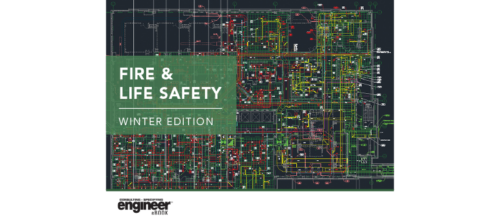Implementing NFPA 101 in hospitals
NFPA 101: Life Safety Code is a reference used for strategies to protect people based on building construction, protection, and occupancy features that minimize the effects of fire and related hazards. It is the only document that covers life safety in both new and existing structures.
Learning Objectives
- Understand NFPA 101: Life Safety Code and its impact on new and existing buildings.
- Learn about NFPA 101 in reference to hospitals and health care facilities.
- Know what changes to expect in the 2018 edition of NFPA 101.
NFPA 101: Life Safety Code is a reference document often adopted as part of a state or local fire code. Regardless of adoption, many design professionals use NFPA 101 for strategies to protect people based on building construction, protection, and occupancy features that minimize the effects of fire and related hazards.
NFPA 101 provides a minimum set of requirements intended to provide a reasonable level of life safety from fire and similar emergencies. The scope of the 2018 edition has been expanded to include hazardous materials, injuries from falls, and emergency communications. NFPA 101 is also unique in that it covers life safety for both new and existing structures more comprehensively than many other codes. For most occupancy classifications, there are separate chapters for new and existing buildings and the code is intended to be applied to existing buildings in a retrospective manner.
Mission critical facilities
Life safety is critical for all occupancies. With respect to mission critical facilities, this will focus on facilities in which it is difficult to evacuate the occupants due to the evacuation capability of the occupants, such as hospitals. Other facilities addressed include those that need to continue to operate during a fire emergency (health care, detention and correctional facilities, etc.). With respect to such facilities, the engineer often finds increased requirements for building construction, compartmentation, and fire protection systems.
NFPA 101 does not include minimum requirements for the height and area of a building based upon construction type for all occupancies, but rather tends to limit such requirements to those occupancies in which evacuation times are expected to be longer (i.e., assembly occupancies, like a theater) or those occupancies in which the emergency procedures are likely to involve the relocation of the occupants instead of evacuation of the building (i.e., health care occupancies).
For example, the construction of a new multistory hospital is limited to noncombustible building construction types (referred to as Type I and Type II as defined in NFPA 220: Standard on Types of Building Construction), and the structural frame is required to have a fire-resistance rating of 1 hour or more (see NFPA 101 Table 18.1.6.1). Health care occupancies use a “defend-in-place” strategy and as such, from the perspective of life safety of the occupants, the integrity of the structural system is more critical than it might be for other occupancies. Because the code anticipates that other regulatory requirements, such as a building code, will address structural-integrity issues associated with property protection and the safety of first responders, building construction need not be restricted for all occupancies.
The construction requirements also may extend beyond the structural frame. In health care occupancies, both new and existing, NFPA 101 requires that non-load-bearing partitions in buildings of Type I and Type II construction be of noncombustible or limited-combustible materials. Whereas fire-retardant-treated wood does not meet the definition of noncombustible or limited combustible, the code specifically permits fire-retardant-treated wood having a required fire-resistance rating of 2 hours or less and only when not part of a shaft enclosure.
With respect to compartmentation, one is likely to find increased requirements for the separation of mission critical occupancies from other occupancies in the same building and increased requirements for smoke compartmentation. For buildings containing multiple occupancies, NFPA 101 contains two options: separated uses or mixed occupancies. The typical separation requirement for mission critical facilities, when the separated-occupancy option is chosen, is a 2-hour fire barrier.
Alternatively, the design professional may choose to provide no separation, in which case the more restrictive requirements of the occupancies involved apply. This is broader than what might be found in some other codes that require the more restrictive requirements for building construction types and fire protection systems, but do not include egress requirements.
Smoke compartmentation
Smoke compartmentation occurs when a building is separated into two or more smoke compartments for the purpose of facilitating the horizontal relocation of the occupants to an area separated from the fire area by smoke barriers. In many cases, such separation may be adequate and no further relocation is required once the occupants are relocated to another smoke compartment. If smoke does migrate into adjacent smoke compartments, the smoke barrier provides additional time for further relocation either horizontally or vertically.
One occupancy in which smoke barriers are commonly used is health care occupancies. The 2018 edition of NFPA 101 has increased the maximum area of a smoke compartment from 22,500 sq ft to 40,000 sq ft for new hospitals and some existing hospitals. However, one limiting factor that was not revised is the travel distance to the smoke barrier door from any point in a smoke compartment, which is still restricted to 200 ft. This travel distance is measured to the doors in the smoke compartment regardless of whether there are doors to the outside or exit stairs within the smoke compartment.
The philosophy for not recognizing exits as a means to meet this requirement is that staff may be more reluctant to move the patients outside or vertically (such as via elevator); therefore, such features do not provide the same benefit as provided by a smoke compartment. The reluctance may be due to the need to continue to provide medical care, due to a weather event, or because of the physical challenges in moving patients vertically.
The increase in the maximum area of smoke compartments for hospitals is based on the fact that design requirements for new hospitals result in increased use of single-patient sleeping rooms and larger treatment areas. In fact, the NFPA 101 Technical Committee was provided with some space-planning studies illustrating the increase in area required to provide patient care in hospitals. When the area for various functions is increased, a larger smoke compartment size does not necessarily translate into more patients being exposed to a fire in the compartment of origin. To limit the application of the increased area to such facilities, the code requires that the larger smoke compartments be limited to those involving single-patient sleeping rooms and suites.
While fire alarm and sprinkler system requirements are found in all occupancy chapters, the threshold as to when such systems are required in mission critical facilities is much lower than in other building types, such as offices. In fact, most mission critical facilities will be required to have a fire alarm system and a sprinkler system regardless of the number of occupants or the size of the building.
When designing a fire protection system for such occupancies, the design professional needs to recognize that the code contains requirements that may be more specific for mission critical facilities than is required by the applicable reference standard. For example, the zoning of a fire alarm system may need to be consistent with the smoke compartmentation or emergency plan for the mission critical facility. Even if not explicitly required by the code, such zoning may be essential for the proper operation of the facility during a fire emergency.
Another example of a more restrictive requirement is the operation of automatic closing doors. Although NFPA 72: National Fire Alarm and Signaling Code allows this function to be on a door-by-door basis, NFPA 101 requires that all automatic closing doors in a health care occupancy that are within a smoke compartment will automatically close upon detection of smoke within that smoke compartment.
Alternatively, the system may be designed to close all automatic closing doors throughout the facility. There also may be some unique considerations in life safety mission critical facilities that need to be addressed regarding occupant notification. One option may be to use the private operating-mode option contained in NFPA 72, which is designed to notify the staff necessary to implement the emergency plan and not necessarily all occupants. The code also may allow for alternative occupant-notification concepts.
For example, NFPA 101 permits the omission of audible alarm-notification appliances in critical care areas of health care occupancies due to the need to hear patient monitor alarms. The 2018 edition of NFPA 99: Health Care Facilities Code expands this provision by allowing the occupant notification to be based on the results of a risk assessment. There are areas of a hospital, such as a neonatal intensive care unit (NICU), in which traditional alarm-notification appliances requirements (audible and visual) may present a risk to the patients that needs to be addressed using an alternative compliance strategy.
Changes in the 2018 edition
One of the more significant changes in the 2018 edition is the expansion of the scope of the document. Historically, NFPA 101 dealt with life safety from fire and similar emergencies. The scope has been expanded to include hazardous materials emergencies, injuries from falls, and emergency communications. With respect to hazardous-materials emergencies, one of the goals of the code is to provide a reasonable level of life safety during emergency events involving hazardous materials regulated by NFPA 30, NFPA 45, NFPA 54, NFPA 55, NFPA 58, NFPA 400, and NFPA 495. The 2018 edition contains a new Annex C, which summarizes the scope and application of the NFPA standards that address certain hazardous materials.
In a sense, the code has dealt with issues associated with injuries and falls by trying to prevent such injuries. Examples include stair riser/tread geometry, handrails, and guardrail requirements. The most noticeable change with respect to injuries from falls is the requirements that have been added to the code regarding grab bars for bathtubs, bathtub-shower combinations, and showers. The language has been added to Chapter 24 (one- and two-family dwellings), but can be referenced by any other chapter (see 24.2.8). The application currently is limited to residential occupancies, although the original intent of the submitter was to include additional occupancies, such as health care occupancies. As happened when some of the stair requirements were added to the code, the rationale for including requirements for grab bars was the fact that they may be needed during a fire emergency as well. With respect to grab bars, the proponent argued that they would be needed during a fire emergency as well as normal use.
With respect to emergency communications, NFPA 101 now contains provisions for a risk assessment in certain occupancies to determine the need for a mass communication system. NFPA 72 contains the requirements for such a risk assessment, but the argument was made that if one does not initially plan to include a mass notification system, the risk assessment may not be performed because one would not go to that section of NFPA 72. By including the language in documents, such as NFPA 101, the risk assessment is now used to determine if a mass notification system is required in addition to determining the design-performance requirements as addressed in NFPA 72.
The need for such a risk assessment has not been added to all occupancy chapters. For some occupancies, the requirement is limited to certain buildings within the occupancy classification, such as business occupancies with college or university classrooms (see 38.3.4.5) and occupant loads for new assembly occupancies (see 12.3.4.5).
Requirements for the testing of integrated fire protection and life safety systems have been added by including a reference to NFPA 4: Standard for Integrated Fire Protection and Life Safety System Testing. The application of NFPA 4, which addresses the testing of integrated fire protection systems, varies between occupancies. There have been a series of Tentative Interim Amendments (TIAs) processed to make the application more consistent between the chapters. Based on the TIA’s, the application of NFPA 4 will typically be limited to high-rise buildings and buildings including smoke-control systems. For more information concerning the TIAs visit www.nfpa.org/101.
With respect to compartmentation, the 2018 edition of NFPA 101 requires that fire barriers, smoke barriers, and smoke partitions in accessible concealed spaces in new construction be marked as such with signs or stenciled letters (see 8.2.2.5). The intent of this requirement is to facilitate the ongoing maintenance of the required compartmentation of buildings. Although compartmentation in mission critical facilities is mentioned previously, this requirement applies to all new construction, regardless of occupancy classification.
Future updates
NFPA 101 addresses life safety in mission critical facilities using the traditional occupancy-classification system and provides increased construction, compartmentation, and fire protection system requirements for such occupancies. In some instances, a subset of the occupancy classification has specific requirements. With respect to mission critical facilities, an example would be the new requirements for medical gas systems in business occupancies to comply with NFPA 99 (see 38.3.2.4). It should be noted that NFPA 101 provides life safety requirements for all occupancies.
With respect to changes in the 2018 Edition of NFPA 101, the article only contains a summary of some of the more significant changes. NFPA 101 is revised on a 3-year revision cycle and everyone is encouraged to submit public input to further improve the document in the future.
William E. Koffel is president of Koffel Associates. He is chair of the NFPA Correlating Committee on Life Safety and a member of several NFPA technical committees. He is a member of the Consulting-Specifying Engineer editorial advisory board.
Do you have experience and expertise with the topics mentioned in this content? You should consider contributing to our CFE Media editorial team and getting the recognition you and your company deserve. Click here to start this process.





